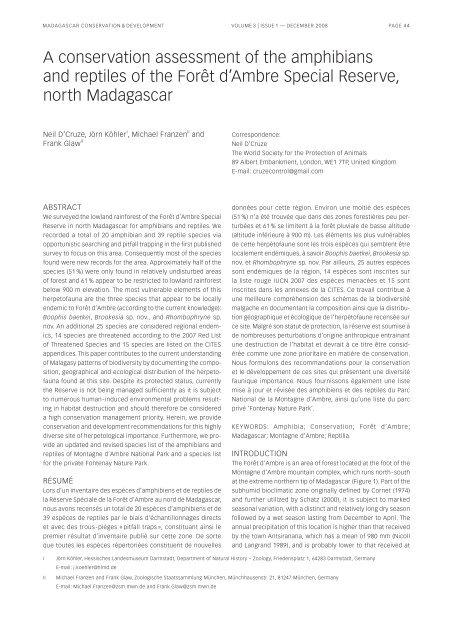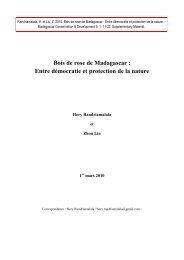Journal Madagascar Conservation - Madagascar Wildlife ...
Journal Madagascar Conservation - Madagascar Wildlife ...
Journal Madagascar Conservation - Madagascar Wildlife ...
You also want an ePaper? Increase the reach of your titles
YUMPU automatically turns print PDFs into web optimized ePapers that Google loves.
MADAGASCAR CONSERVATION & DEVELOPMENT VOLUME 3 | ISSUE 1 — DECEMBER 2008 PAGE 44<br />
A conservation assessment of the amphibians<br />
and reptiles of the Forêt d’Ambre Special Reserve,<br />
north <strong>Madagascar</strong><br />
Neil D‘Cruze, Jörn Köhler I , Michael Franzen II and<br />
Frank Glaw II<br />
ABSTRACT<br />
We surveyed the lowland rainforest of the Forêt d’Ambre Special<br />
Reserve in north <strong>Madagascar</strong> for amphibians and reptiles. We<br />
recorded a total of 20 amphibian and 39 reptile species via<br />
opportunistic searching and pitfall trapping in the first published<br />
survey to focus on this area. Consequently most of the species<br />
found were new records for the area. Approximately half of the<br />
species (51 %) were only found in relatively undisturbed areas<br />
of forest and 61 % appear to be restricted to lowland rainforest<br />
below 900 m elevation. The most vulnerable elements of this<br />
herpetofauna are the three species that appear to be locally<br />
endemic to Forêt d’Ambre (according to the current knowledge):<br />
Boophis baetkei, Brookesia sp. nov., and Rhombophryne sp.<br />
nov. An additional 25 species are considered regional endemics,<br />
14 species are threatened according to the 2007 Red List<br />
of Threatened Species and 15 species are listed on the CITES<br />
appendices. This paper contributes to the current understanding<br />
of Malagasy patterns of biodiversity by documenting the composition,<br />
geographical and ecological distribution of the herpetofauna<br />
found at this site. Despite its protected status, currently<br />
the Reserve is not being managed sufficiently as it is subject<br />
to numerous human - induced environmental problems resulting<br />
in habitat destruction and should therefore be considered<br />
a high conservation management priority. Herein, we provide<br />
conservation and development recommendations for this highly<br />
diverse site of herpetological importance. Furthermore, we provide<br />
an updated and revised species list of the amphibians and<br />
reptiles of Montagne d’Ambre National Park and a species list<br />
for the private Fontenay Nature Park.<br />
RÉSUMÉ<br />
Lors d’un inventaire des espèces d’amphibiens et de reptiles de<br />
la Réserve Spéciale de la Forêt d’Ambre au nord de <strong>Madagascar</strong>,<br />
nous avons recensés un total de 20 espèces d’amphibiens et de<br />
39 espèces de reptiles par le biais d’échantillonnages directs<br />
et avec des trous - pièges « pitfall traps », constituant ainsi le<br />
premier résultat d’inventaire publié sur cette zone. De sorte<br />
que toutes les espèces répertoriées constituent de nouvelles<br />
Correspondence:<br />
Neil D’Cruze<br />
The World Society for the Protection of Animals<br />
89 Albert Embankment, London, WE1 7TP, United Kingdom<br />
E-mail: cruzecontrol@gmail.com<br />
données pour cette région. Environ une moitié des espèces<br />
(51 %) n’a été trouvée que dans des zones forestières peu perturbées<br />
et 61 % se limitent à la forêt pluviale de basse altitude<br />
(altitude inférieure à 900 m). Les éléments les plus vulnérables<br />
de cette herpétofaune sont les trois espèces qui semblent être<br />
localement endémiques, à savoir Boophis baetkei, Brookesia sp.<br />
nov. et Rhombophryne sp. nov. Par ailleurs, 25 autres espèces<br />
sont endémiques de la région, 14 espèces sont inscrites sur<br />
la liste rouge IUCN 2007 des espèces menacées et 15 sont<br />
inscrites dans les annexes de la CITES. Ce travail contribue à<br />
une meilleure compréhension des schémas de la biodiversité<br />
malgache en documentant la composition ainsi que la distribution<br />
géographique et écologique de l’herpétofaune recensée sur<br />
ce site. Malgré son statut de protection, la réserve est soumise à<br />
de nombreuses perturbations d’origine anthropique entrainant<br />
une destruction de l’habitat et devrait à ce titre être considérée<br />
comme une zone prioritaire en matière de conservation.<br />
Nous formulons des recommandations pour la conservation<br />
et le développement de ces sites qui présentent une diversité<br />
faunique importance. Nous fournissons également une liste<br />
mise à jour et révisée des amphibiens et des reptiles du Parc<br />
National de la Montagne d’Ambre, ainsi qu’une liste du parc<br />
privé ‘Fontenay Nature Park’.<br />
KEYWORDS: Amphibia; <strong>Conservation</strong>; Forêt d’Ambre;<br />
<strong>Madagascar</strong>; Montagne d’Ambre; Reptilia.<br />
INTRODUCTION<br />
The Forêt d’Ambre is an area of forest located at the foot of the<br />
Montagne d’Ambre mountain complex, which runs north - south<br />
at the extreme northern tip of <strong>Madagascar</strong> (Figure 1). Part of the<br />
subhumid bioclimatic zone originally defined by Cornet (1974)<br />
and further utilized by Schatz (2000), it is subject to marked<br />
seasonal variation, with a distinct and relatively long dry season<br />
followed by a wet season lasting from December to April. The<br />
annual precipitation of this location is higher than that received<br />
by the town Antsiranana, which has a mean of 980 mm (Nicoll<br />
and Langrand 1989), and is probably lower to that received at<br />
I Jörn Köhler, Hessisches Landesmuseum Darmstadt, Department of Natural History – Zoology, Friedensplatz 1, 64283 Darmstadt, Germany<br />
E-mail: j.koehler@hlmd.de<br />
II Michael Franzen and Frank Glaw, Zoologische Staatssammlung München, Münchhausenstr. 21, 81247 München, Germany<br />
E-mail: Michael.Franzen@zsm.mwn.de and Frank.Glaw@zsm.mwn.de



